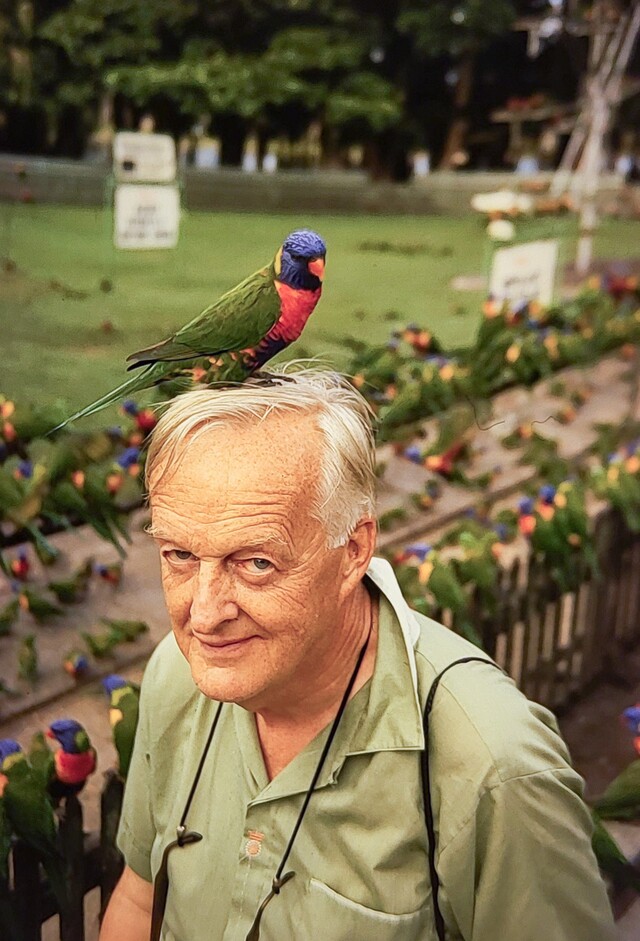
Feeding wild birds draws mixed reaction from encouragement to absolute disapproval. Influential environmental, governmental and other agencies roundly condemn the practice, but this is unique to Australia.
In Europe and North America, by contrast, bird-feeding carries the blessing of bird lovers who do all they can to promote it.
Looking at the literature, the tide turned against wild bird feeding in the 1980s from encouragement to condemnation as historian Adjunct Professor Russell McGregor of James Cook University pointed out when he attempted last week at Noosa Parks Association’s Friday Forum to offer some tentative answers as to why that came about? He concludes the reason is more moral than scientific in basis.
Russell told attendees that for most the 20th century, Australian birders enjoyed unimpeded feeding of birds.
An article in Nature magazine in 1940s urged friendships with birds, observing bird feeding as a social exercise, he said.
Sydney lawyer and respected birder Harry Wilson in 1980 wrote in The Emu, a respected bird journal, of fostering friendships with fairy wrens in his backyard.
“This is common stuff in The Emu of those days,” Russell said.
Some birders used food to lure birds to their cameras but most of the time birders fed birds not for any ulterior motive but for sheer joy of interacting with wild creatures, he said.
Until the 1990s literature carried no hint of a need to justify the practice. It was just an observation as an unremarkable activity.
“The growth of an anti-feeding stance was gradual, piecemeal, harsh, beginning in 1980s, and intensifying thereafter,” he said.
“Many birders didn’t participate in it. Eminent birder Graham Pizzey continued to advocate feeding birds, after it became controversial.”
In 1985 Ellen McCullough in what is now Birdlife Australia magazine noted opinions regarding bird feeding ranged from disagreement with the practice to those who had to get in a bird sitter before going on holidays.
In the 1990s opposition to bird feeding stiffened, Russell said.
In 1996 The Bird Observer editor Zowie Wilson remarked that the European tradition of providing supplementary food to birds to survive icy winters was completely inappropriate for Australia and instead recommended attracting birds by planting native plants.
“Never allow birds to become dependent. Don’t feed them every day. Constant artificial feeding makes them fat and lazy,” she advised.
The tides were turning against feeding, but stopped short of total opposition.
A 1998 Bird watching field guide noted that there was debate over the matter of feeding birds in gardens, some regarding It as an “immoral act”, and preferred the more natural option of planting native bird-attracting trees and shrubs.
It counselled moderation, warned against birds becoming dependent on human-provided food and “overweight suburban freeloaders”.
By 2000 Wingspan magazine editor advised readers the best source of feed for native birds was native plants, but if they wanted to feed them to do so on adhoc basis so they didn’t become dependent, Russell said.
Birdlife Australia never had a formal policy on bird feeding but since the 1990s discouraged the practice.
Russell said non-feeding of birds was much stronger in non-birding circles and noted ecologist Daryl Jones agreed with his assessment.
In the 1980s and 90s, in contrast, Europe and America bird feeding was increasingly encouraged.
One possible explanation for the Australian response was an awareness of avian disease and feeding as an agent of transmission of avian disease, Russell said. But this was known before the 1980s, just before tide on attitudes began to turn.
“There was no evidence of an outbreak around the 1980s nor evidence of it in birding literature,” he said.
The knowledge of avian disease was more confined to veterinarian literature, and while the role of feeding and spreading disease has become a factor against feeding more recently that was not the case in 1980s. The big issue in 1990s was dependency. There were outbreaks of avian disease overseas too but the response there was to inform the public to be more careful.
Opinions were mixed. Graham Pizzey warned against dependency in his book A Garden of Birds, but also gave advice on how to feed birds.
Russell concluded it was a puzzle with no single factor, but his explanation lends something to a purest conception of nature associated with the wilderness movement, “celebrating wilderness patches of the planet that have escaped the hand of humankind”.
He said the most strident opposition came from wilderness movements worldwide but the rest of the world did not experience the backlash against feeding.
The answers lie more in the realms of morals than science. “Some birders regard the act as an immoral act,” he said.
A retired avian veterinarian in the audience suggested the sway of opinion may have resulted from an increased knowledge of nutrition and disease resulting from poor nutritional feeding, but Russell discounted this.
The same issues of avian nutrition were met overseas but the response was to get better food,” he said. “Sectors in Australia were against feeding altogether.
There was no good advice to Australian people where feeding overseas had the support of official bodies, he said. “That advice wasn’t getting through because of that official opposition”.
Russell’s next book, Enchantment by Birds: A history of birdwatching in 22 species, will be published by Scribe next February. It has something to say about bird feeding.






